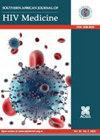南部非洲艾滋病毒临床医生协会关于在一线抗逆转录病毒治疗中使用多替格拉韦的指南。
IF 1.6
4区 医学
Q4 INFECTIOUS DISEASES
Southern African Journal of Hiv Medicine
Pub Date : 2018-10-17
eCollection Date: 2018-01-01
DOI:10.4102/sajhivmed.v19i1.917
引用次数: 6
摘要
本文章由计算机程序翻译,如有差异,请以英文原文为准。
Southern African HIV Clinicians Society Guidance on the use of dolutegravir in first-line antiretroviral therapy.
In preliminary data from the Tsepamo study in Botswana, it was found that 0.94% (95% confidence interval [CI]: 0.37 – 2.4) of babies (4/426) born to women who were taking dolutegravir periconception had neural tube defects (NTDs), compared with 0.1% of babies (14/11 173) of women taking other antiretroviral drugs (ARVs) in the periconception period.1 No NTDs were observed in pregnancies where dolutegravir was initiated later in pregnancy. Further data from the Tsepamo study were presented at AIDS 2018: the updated number of NTDs with periconception dolutegravir exposure in the Tsepamo cohort is 4/596, 0.67% (95% CI: 0.26 to 1.7). The next formal analysis will occur after 31 March 2019 and will include women exposed to dolutegravir from conception before the recent change in guidance. Tsepamo plans to expand the number of study sites, increasing the coverage from 45% to 72% of births in Botswana with a projected denominator of over 1200 by March 2019.1
求助全文
通过发布文献求助,成功后即可免费获取论文全文。
去求助
来源期刊
CiteScore
2.80
自引率
11.80%
发文量
41
审稿时长
>12 weeks
期刊介绍:
The Southern African Journal of HIV Medicine is focused on HIV/AIDS treatment, prevention and related topics relevant to clinical and public health practice. The purpose of the journal is to disseminate original research results and to support high-level learning related to HIV Medicine. It publishes original research articles, editorials, case reports/case series, reviews of state-of-the-art clinical practice, and correspondence.

 求助内容:
求助内容: 应助结果提醒方式:
应助结果提醒方式:


